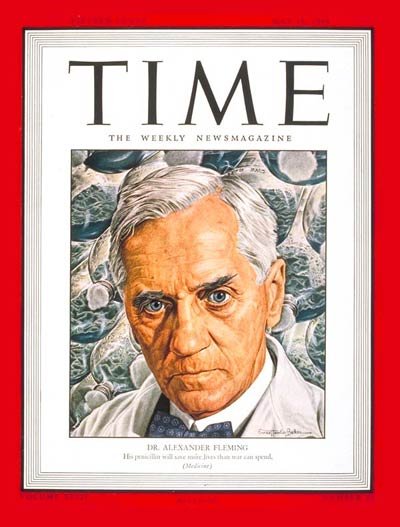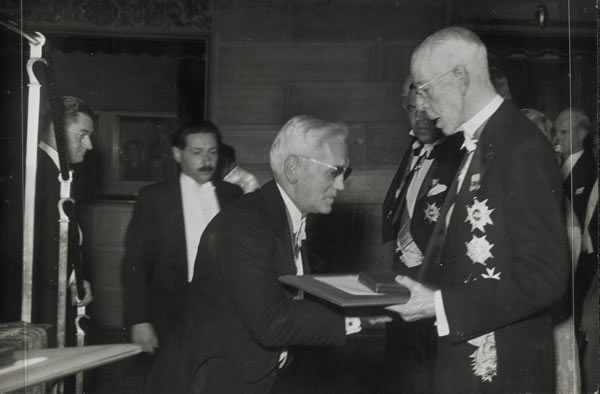Biography of Alexander Fleming
The Scottish biologist Alexander Fleming discovered the enzyme lysozyme and the antibiotic penicillin.

Childhood of Alexander Fleming
Alexandra Fleming was born on August 6, 1881 in Lochfield, on a farm near Darwel in Ayrshire, in Scotland. Fleming was the third of four children in the family of Hugh Fleming and Grace Stirling Morton. Father Alexander lost at the age of 7 years.

Education
Education Fleming received at the school of Laudon Moore and at the school of Darvel. For two years he worked hard to enter the Kilmarnock Academy. After graduating from high school, Fleming goes to London, where he enters the Royal Polytechnic Institute.
For 4 years, Fleming serves in the fleet, and then receives the inheritance left to him by his uncle.
Following the advice of his older brother, Tom, a physicist by profession, Alexander begins to study science. In 1903, he took a job at St. Mary's Hospital, where, in 1906, he received a qualification that would allow him to practice surgical practice.
Military career
At one time, Alexander was an honorary member of the shooting club. Since 1900 he has been actively participating in a group of volunteers, consisting of civilians, trained in rifles and large-caliber weapons, as well as in pathological anatomy. This group gained great popularity in the middle of the XIX century, and many members of the volunteer associations that entered it entered the service in the British Army. The head of the shooting club insists that Fleming stay in the team, and he joins the research group of the hospital of St. Mary, where he later becomes a student of Sir Almroth Wright, one of the founders of vaccination and immunology. In this field of medicine soon takes a worthy place and Fleming, receiving a Bachelor of Medicine degree, and after, in 1908, defending with a gold medal and a Bachelor of Science degree. After that, Fleming remains a teacher at St. Mary's Hospital, where she will work until 1914.
This year, Fleming is called for the First World War, where, as captain of a group of military pathologists of the Royal Army, receives a reward for courage. Fleming will go through the whole war. Together with colleagues, he serves in field hospitals on the Western Front in France. Only in 1918 he returned to the hospital of St. Mary, which by that time had become an educational hospital. In 1928, Fleming became a professor of bacteriology.

Research work on penicillin
The war had a great influence on the scientific views of Fleming. Becoming a witness to countless deaths of soldiers, Fleming makes every effort to research antibacterial agents, setting a goal to create a medicine that can conquer infections and heal wounds. The idea of creating a simple antiseptic that does not in any way affect the rapid spread of bacterial infection, but instead reduces the protective function of the body of the sufferer, Fleming does not entice. In an article that appeared during the First World War in the medical journal The Lancet, Fleming popularly describes the harmful nature of antiseptics, setting forth his experiment, clearly demonstrating why the number of deaths from antiseptics during the war exceeds the number of deaths in combat. The scientist proves to the world that antiseptics are good only for caring for superficial wounds, but are not applicable to deep wounds. Thorough research Fleming of the uselessness of antiseptics in the treatment of deep wounds is actively supported by Sir Almroth Wright. But, despite the results of these studies, some doctors continue to use these drugs in the treatment of the wounded in the war, than only worsen their condition.
Thanks to his scientific research, Fleming is becoming widely known. By 1928, he began to study the properties of bacteria of the family of staphylococcus. At this point, the scientist has already earned himself the name of an outstanding researcher. According to eyewitnesses, Fleming never watched the order in his laboratory. On September 3, 1928, after returning from a vacation lasting a whole month, he suddenly discovers that staphylococci (negligently thrown on the bench at the very beginning of the holiday) are affected by fungal formations. Fleming perceptively notes that the colonies of bacteria that were in the immediate vicinity of the affected microorganisms died, while those that were at a distance remained in normal condition. Affected bacteria Fleming shows his former assistant Merlin Price, who confirms that Fleming, quite by accident, managed to get lysozyme. So the scientist decides to grow mold in pure form, and, thus, allocates an element killing a number of pathogenic bacteria. The resulting mold belongs to the penicillin group. In a couple of months, on March 7, 1929, he would call the substance "penicillin" allocated to him. Fleming conducts in-depth studies of the positive properties of the drug (its antibacterial effect) and finds that it affects a number of bacteria - such as staphylococcus and other gram-positive pathogens, causing scarlet fever, pneumonia, meningitis and diphtheria. In 1929 he publishes the results of his works in the journal British Journal of Experimental Pathology, but the article does not attract much attention to the scientific world.
In the process of work, Fleming faces difficulties in isolating and collecting penicillin, associated with problems of complete isolation of the antibiotic agent. The researcher continues the research, but comes to the conclusion that the drug has too slow action in order to play an important role in the treatment of infections. Along with this, his confidence grows that penicillin can not have a lasting effect on the human body for effective control of bacteria. Therefore, some of Fleming's research remains incomplete. But in the 1930s. Fleming's research is taking a more confident outline. Until the early 1940's. he tries to attract the attention of chemists to the need to further improve the form of penicillin, suitable for use.
After a few years, Fleming leaves his work on the drug. However, very soon, scientists Flory and Cheney from the Radcliffe Hospital, based at Oxford University, are resuming research and, with the support of US and British foundations, are successfully receiving a stable form of penicillin. The bombing of Pearl Harbor, which took place on December 7, 1941, gives impetus for the mass release of the drug by the hospital, which will be used to treat the wounded of all the allied armies.

Personal life
December 23, 1915 Fleming marries an experienced nurse Sarah Marion McElroy. In 1949, she died, leaving Alexander with their only son, Robert Fleming, who later became a doctor-therapist. April 9, 1953 Alexander Fleming again marries, this time with Dr. Amalia Kutsuri-Vurekas - his Greek counterpart in the hospital of St. Mary, a scientist with whom he was associated throughout his life.

Awards and honors
The accidental, but obvious, discovery by Fleming of penicillin radically turned the world of medicine. The birth of antibiotics and modern medicine have opened a great future for the successful treatment of millions of people around the world. In 1944, Fleming, along with his colleague Flory, was knighted. In 1945, together with Flori and Cheyne, he received the Nobel Prize in medicine. The Royal College of Physicians of England honored Fleming with the title of Honorary Member of the London Hunterian Society.
Death
Fleming died in 1955, in his own house, from a heart attack. A week after his death, the body was cremated, and ashes are buried in the Cathedral of St. Paul in London.
